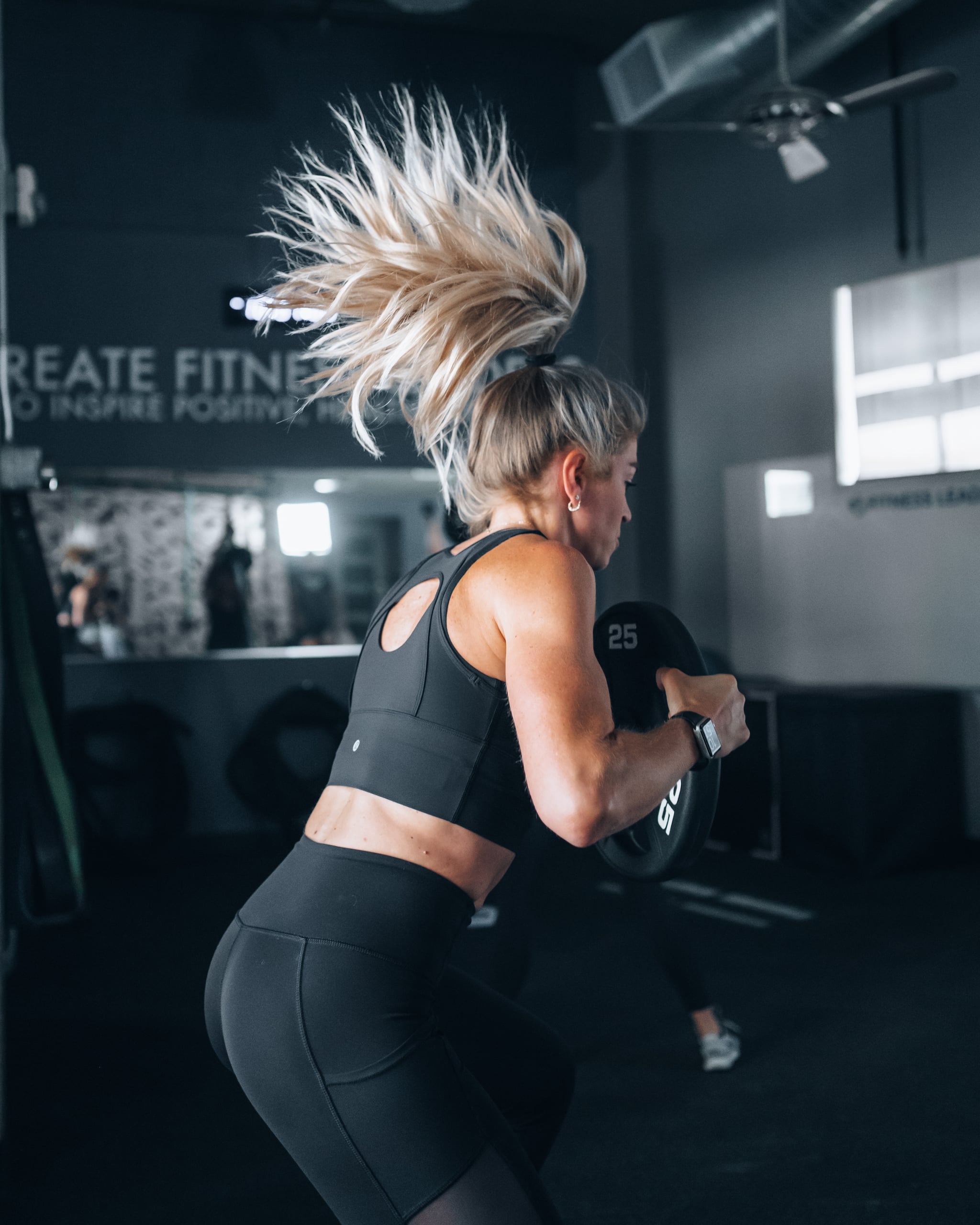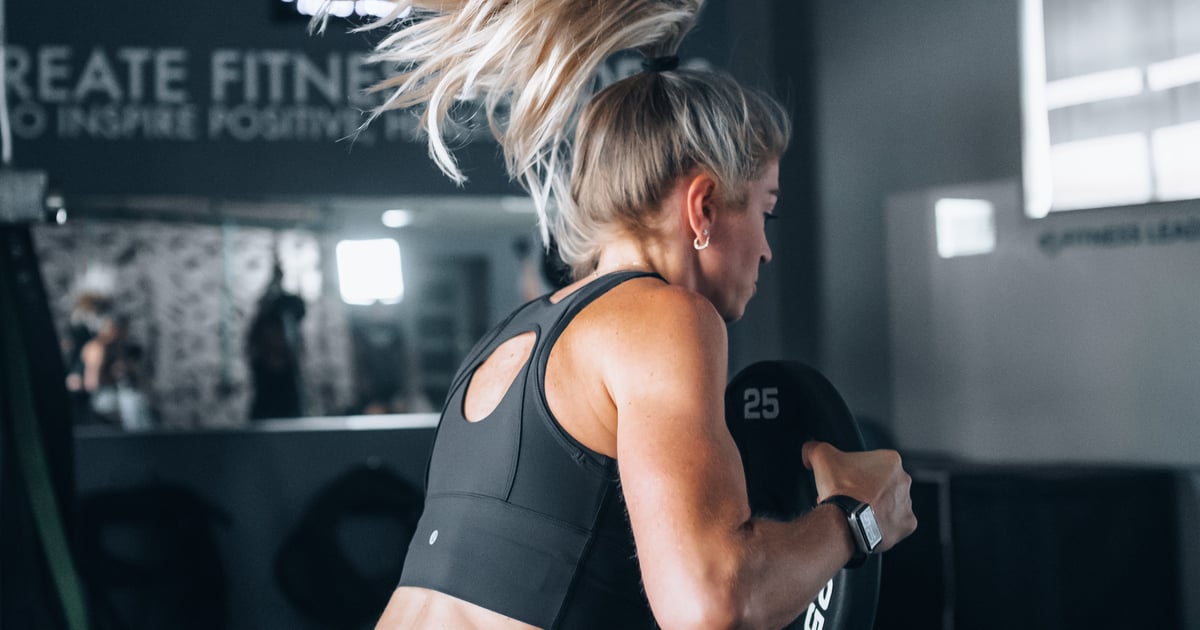
Muscle soreness is about as comfortable as running into your ex in the weight room (meaning, not at all). And even worse is delayed onset muscle soreness (DOMS), which can be even more brutal.
Though they’re not exactly the same thing (more on that later), muscle soreness and DOMS are often used interchangeably, and both refer to muscle tenderness, pain, or stiffness caused by athletic activity. If you’ve ever struggled to bend down and pick something up after a leg day workout, or couldn’t comfortably walk up the stairs after a long run, you know firsthand what muscle soreness or DOMS feels like. But why do muscles get sore in the first place?
While muscle soreness is generally not fun to deal with, there’s a silver lining: it’s often a symptom that you pushed hard enough to make gains, says exercise physiologist and certified strength and conditioning coach Sharon Gam, PhD, CSCS. Still, there’s a difference between “good” muscle soreness and muscle soreness that could actually be a problem (i.e. an injury). Ahead, exercise pros answer all of your questions about muscle soreness, DOMS, and what you can do about them.
What Are DOMS? Different Types of Muscle Soreness
Commonly shortened to DOMs, “delayed onset muscle soreness names pain, tenderness, and/or stiffness in the muscles that you’ve exercised after you’ve exercised them,” says Dr. Gam. That first qualifier (“delayed onset”) is there because it’s soreness that doesn’t prop up right after you’ve exercised, she explains.
To be clear: DOMS is different from your typical muscle soreness. “Both muscle soreness and DOMS share common characteristics, but they differ in timing,” says Rachel Straub, PhD, CSCS, coauthor of “Weight Training Without Injury.”
Regular muscle soreness can begin immediately after physical activity, while DOMS typically takes about 24 hours to set in, Dr. Straub says. Plus, “regular muscle soreness is generally transient and lasts only hours,” she says, while it can take DOMS anywhere from three to seven days to slowly dissipate and go away. DOMS typically reaches its peak between 24–72 hours after your workout, research shows.
DOMS is also different from the acute muscle soreness you might feel while you’re exercising, says Dr. Gam (think: the burning feeling when you’re holding a squat or doing nonstop core work in Pilates). “When you are ‘sore’ in the middle of the workout, [that] soreness is typically caused by the accumulation of lactic acid and hydrogen ions,” she says. Lactic acid is a waste product the body produces when turning glucose into energy to fuel your muscles during exercise, she says. “While lactic acid can cause discomfort during exercise, it’s cleared from the muscles very quickly after exercise and is different from — and does not cause — DOMS.”
Why Do Muscles Get Sore?
Put simply, muscles get sore because exercise causes damage to the tissue, which leads to an inflammatory response, explains Ellen Thompson, head personal trainer at Blink Fitness.
Whether it’s on the trail or in the weight room, every time you challenge your muscles beyond their current ability, tiny tears are shorn into your muscle fibers and damage is done to the surrounding connective tissues, explains Dr. Gam. Exercise-induced damage may sound like a bad thing, but it’s actually the first and most essential step in making your muscles bigger and stronger. The fact is, when your body repairs the damage, it rebuilds your muscle fibers so that they’re even more resilient than they were before, she explains, which translates to you becoming stronger and more capable.
These micro tears create an inflammatory response in the body, which results in the perception of pain that registers as muscle soreness, Dr. Straub says. It also prompts your body to increase blood flow to the area to start the recovery process.
Blood is rich in oxygen and nutrients that help repair the muscle fibers, so bringing blood to the area helps to speed up recovery. Increased blood flow also speeds up the rate at which metabolites (or “muscle waste”) are carried away from the muscles, Thompson says. This so-called “waste” can increase your experience of pain and fatigue, according to research, so clearing it out can decrease those sensations. The blood flow can also help reduce any stiffness you’re experiencing as a result of DOMS, she says.
Which Workouts Are Most Likely to Cause Sore Muscles?
DOMS is a likely side effect anytime you push your muscles beyond their current ability. So, if you do a workout at a higher intensity — whether you’re running (or cycling or rowing) faster, or lifting more weight (or doing more reps) — than your body is used to, DOMS is to be expected, says Dr. Gam.
Eccentric exercises — that is, exercises that focus on the lengthening of the muscle — are also especially likely to lead to DOMS muscle soreness, according to to research. Also known as “negatives,” eccentric exercises (for example, slowly lowering down from the top of a pull-up or push-up) place greater stress on the muscle compared to exercises that focus on contracting the muscle in another way. Greater stress on the muscle results in greater muscle breakdown, which leaves you more sore.
People are who new to exercise are also especially prone to DOMs, per Dr. Gam. That’s because their muscles are not conditioned to exercise, she says, so any physical activity pushes their muscles past their current ability. This is also why you might be sore after trying a new type workout even if you’re physically active in other ways; the muscles worked by the new workout (say, your upper back during boxing) might not be conditioned from your usual routine (like your quads from running).
This is exactly why experts recommend exercisers start new exercise routines with a “slow and steady wins the race” mindset. “If your soreness is consistently greater than a 3/10, you put yourself at an increased risk for injury, because when the body is sore it can try to protect itself by changing movement patterns,” says Dr. Gam. Plus, if you’re that sore, you’re less likely to show up to the gym consistently, and consistency is where the real gains are made, she says.
How to Deal With Sore Muscles
When you’re sore, your sofa may look especially appealing. But actually, Thompson recommends against being a couch potato for the day.
Motion is lotion, she says, “so completely relaxing for the day may worsen the pain.” Instead, she recommends doing some low-intensity exercise, like going on a hot girl walk or easy run, taking a yoga class, or doing a mobility flow. Gentle exercise keeps your blood flowing properly so your cardiovascular system can deliver nutrients to your muscles and clear away waste products, she explains.
When you’re not moving and grooving, you want to provide your body with what it needs to heal muscle damage quickly, says Dr. Gam. “The bulk of muscle recovery and growth happens when you’re asleep, so getting enough good quality sleep is essential,” she says. “Eating high-quality, nutrient-dense foods including plenty of protein gives your body the tools it needs to complete the recovery process and heal sore muscles.”
Are Sore Muscles a Good Sign? When Is Soreness a Problem?
In most instances, sore muscles are a good sign; it’s simply an indication that you’ve challenged your body and it’s working its damnedest to adapt to the exercise regime you’re putting it through. That said, you don’t need to be extremely sore to have had a good or worthwhile workout. You can reap so many of the wonderful health benefits of exercise, like reduced stress and improved cardiovascular health, even if you aren’t sore the next day.
There’s also a difference between productive muscle soreness after a workout and a serious problem. So, how can you tell which is which?
For starters, when someone is injured, they can often remember a specific “moment” while they were exercising that marked the start of the pain, Dr. Straub says. “If you experience a sudden sharp pain that feels abnormal when you’re exercising, or hear a pop, odds are you’ve endured a severe injury.” Plain muscle soreness, however, is rarely marked by a single auditory or sensory moment, but rather builds over time, and always after you’re done working out.
Further, “when an individual has a serious muscular injury that requires medical attention — like a muscle strain or stress fracture — the underlying pain does not lessen nor improve within a few days,” says Dr. Straub. Rather, the pain either stays the same or gets worse. If you’re still in pain five or more days after a workout, that’s a sign you may have an injury on your hands.
Duration of pain aside, the intensity of the pain can also help you deduce whether its muscle soreness is something more worrisome. DOMS is often marked by generalized muscle fatigue and joint stiffness, says Thompson. Your muscles may even be tender to the touch, she says. “Soreness that might be described as sharp, shooting, or throbbing, or is accompanied by intense swelling and throbbing, is also likely an injury.”
And in very rare cases, excessive exercise that causes significant muscle damage can lead to kidney failure and a life-threatening condition called rhabdomyolysis. Common signs of the condition are weak muscles, muscle stiffness, muscle pain, and a change in your pee color, per the Cleveland Clinic. If you have excessive muscle soreness, muscle swelling, or dark urine, see your healthcare provider right away.
Overall, if you’re unsure if your muscle soreness is a simple case of DOMS or something more serious, head to your physical therapist or other health-care provider. They’ll be able to run through some basic tests to determine the cause of your soreness and provide the next steps for healing if needed.
